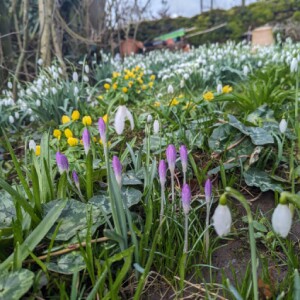Inkling
Two ends of the production line (main & extra), except they do not quite match up. In the first place, the flowers and the hive are on opposite sides of the hill - too far for the journey on cold wings. And that pollen is the wrong colour for snowdrop (bright orange) or crocus (orange-yellow). I did see some orange pollen going into the hive, but was not fast enough with the camera. This more austere, limestone colour is probably hazel, which we planted near-at-hand (wing)
This is the sight a beekeeper hopes for in the first inklings of spring - signs of life. Bringing in pollen means the bees have the intention of digesting it and using the protein it provides to secrete nutritious 'brood food' to feed their larvae. That, in turn, means they hope there will be larvae to feed! Seeing them gathering pollen is not proof-positive that all is well, the queen is laying and the colony is building up from its mid-winter low, but it's a very good sign. Today was not very sunny; the temperature was well below ten degrees and this was mid-afternoon. This level of commitment is encouraging to see
The second bee is welcoming her home - or, more accurately, using her antennae to check that the chemical 'signature' given off by her body matches that of the colony. Even in winter, they take care not to admit strangers. The entrance arches look big in comparison with these winter bees (smaller than their summer born and reared sisters). The size of the entrance tunnels are designed to be comfortably big enough for a bee, but not for a mouse
I think we have reached peak-snowdrop. I've been waiting to take the picture until they reached their frothiest - it's a sort of annual ritual. The early crocus and expanding patch of aconite are a bonus


Comments
Sign in or get an account to comment.


